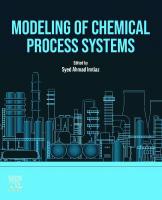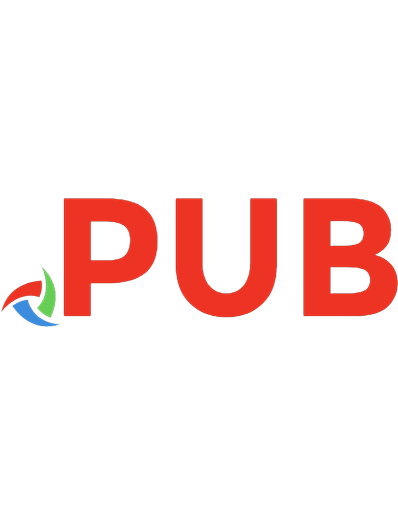Multi-Paradigm Modelling Approaches for Cyber-Physical Systems [1 ed.] 0128191058, 9780128191057
Multi-Paradigm Modelling for Cyber-Physical Systems explores modeling and analysis as crucial activities in the developm
207 27 11MB
English Pages 314 [316] Year 2020
![Multi-Paradigm Modelling Approaches for Cyber-Physical Systems [1 ed.]
0128191058, 9780128191057](https://dokumen.pub/img/200x200/multi-paradigm-modelling-approaches-for-cyber-physical-systems-1nbsped-0128191058-9780128191057.jpg)
Table of contents :
Front Cover
Multi-Paradigm Modelling Approaches for Cyber-Physical Systems
Copyright
Contents
List of contributors
1 Introduction
1.1 Objectives
1.2 Outline of the book
1.2.1 Part 1 – Ontological framework
1.2.2 Part 2 – Methods and tools
1.2.3 Part 3 – Case studies
1.3 Acknowledgements
Part 1 Ontological framework
2 An ontological foundation for multi-paradigm modelling for cyber-physical systems
2.1 Introduction
2.2 Ontology development approach
2.2.1 Modelling modes
2.2.2 Domain analysis process
2.3 Modelling languages and tools
2.3.1 Feature modelling and FeatureIDE
2.3.2 Web Ontology Language (OWL) and Protégé
2.3.3 Integrating feature modelling and OWL
2.4 Ontology architecture
2.5 Shared ontology
2.5.1 Linguistic Domain Concepts (LinguisticDC)
2.5.1.1 Languages
2.5.1.2 Syntaxes
2.5.1.3 Semantics
2.5.2 Workflow Domain Concepts (WorkflowDC)
2.5.3 Project Management Domain Concepts (ProjectManagementDC)
2.5.3.1 Stakeholders and project organisation
2.5.3.2 Resources
2.5.3.3 Project and project phases
2.5.4 Architecture Domain Concepts (ArchitectureDC)
2.5.5 Paradigm Domain Concepts (ParadigmDC)
2.6 Introduction of examples
2.6.1 Ensemble-based cyber-physical system
2.6.1.1 Overview
2.6.1.2 CPS case study
2.6.1.3 Tool chain
2.6.2 HPI cyber-physical systems lab
2.6.2.1 Overview
2.6.2.2 CPS case study
2.6.2.3 Tool chain
2.7 Conclusion
References
3 A feature-based ontology for cyber-physical systems
3.1 Introduction
3.2 Metamodel of cyber-physical systems
3.3 Feature model of cyber-physical systems
3.3.1 Top-level feature diagram
3.3.2 CPS constituent elements
3.3.3 Non-functional requirements
3.3.4 Application domains
3.3.5 Disciplines
3.4 Architecture of CPS
3.5 Examples
3.5.1 Ensemble-based cyber-physical system
3.5.2 HPI cyber-physical systems lab
3.6 Conclusion
References
4 An ontology for multi-paradigm modelling
4.1 Introduction
4.2 State of the art
4.2.1 Core modelling concepts
4.2.2 Multi-formalism modelling approaches
4.2.3 Model management approaches
4.2.3.1 Construction of models and modelling languages
Model elements and model links
Interfaces
Metamodel composition
4.2.3.2 Construction of model operations
Flow composition approaches
Context composition approaches
4.2.3.3 Model management approaches
Model integration languages
Megamodels
4.3 MPM ontology
4.3.1 Core modelling notions
4.3.2 Micromodelling scale
4.3.3 Megamodelling scale
4.3.3.1 Modelling language
4.3.3.2 Megamodel
4.3.3.3 Activity performers
4.3.3.4 Formalism
4.4 Examples
4.4.1 Ensemble-based cyber-physical system
4.4.1.1 Overview
4.4.1.2 Formalism, modelling languages, models, and tools
4.4.1.3 Simulation stage
4.4.2 HPI CPSLab
4.4.2.1 Overview
4.4.2.2 Formalism, languages, models, and tools
4.4.3 Simulation stage
4.4.3.1 Model Test (MT)
4.4.3.2 Model Test – MPM ontology
4.4.3.3 Model-in-the-loop
4.4.3.4 Model-in-the-loop – MPM ontology
4.4.3.5 Rapid prototyping
4.4.3.6 Rapid prototyping – MPM ontology
4.4.3.7 Prototyping stage
4.4.3.8 Software in the Loop (SiL)
4.4.3.9 Software in the Loop (SiL) – MPM ontology
4.4.3.10 Hardware in the Loop (HiL)
4.4.3.11 Hardware in the Loop (HiL) – MPM ontology
4.5 Conclusion
References
5 An integrated ontology for multi-paradigm modelling for cyber-physical systems
5.1 Introduction
5.2 State of the art
5.2.1 Viewpoints
5.2.2 Model-based development process modelling
5.2.3 Modelling paradigms
5.3 Ontology
5.3.1 Viewpoint
5.3.2 Model-based workflows
5.3.2.1 Model-based process
5.3.2.2 Activity performers
5.3.3 Modelling paradigms
5.4 Examples
5.4.1 EBCPS
5.4.1.1 Methodology
5.4.1.2 Methodology implementing process
5.4.2 HPI CPSLab
5.4.2.1 Methodology
5.4.2.2 Methodology implementing process
5.4.2.3 Simulation stage
5.4.2.4 Prototyping stage
5.4.3 Modelling paradigms
5.5 Conclusion
References
Part 2 Methods and tools
6 Enabling composition of cyber-physical systems with the two-hemisphere model-driven approach
6.1 Introduction
6.2 Components of cyber-physical systems
6.3 Cyber-physical systems in the context of system composition
6.4 Two-hemisphere model-driven approach
6.5 The two-hemisphere model-driven approach for solving composition problems
6.6 Conclusions
Acknowledgements
References
7 Multi-paradigm modelling and co-simulation in prototyping a cyber-physical production system
7.1 Introduction
7.2 Case study description
7.3 Techniques
7.3.1 The INTO-CPS technology
7.3.2 Initial models
7.3.3 Discrete-event first with VDM-RT/Overture
7.4 Methodology
7.5 Modelling of the subsystems
7.5.1 Subsystem models
7.6 Verification & validation
7.6.1 Homogeneous phase experiments
7.6.2 Analysis of the homogeneous simulation in relation to the physical system
7.6.3 Heterogeneous phase experiments
7.7 Conclusion
7.7.1 Two-phase development
7.7.2 Methodological insights
Acknowledgements
References
8 Agent-based cyber-physical system development with SEA_ML++
8.1 Introduction
8.2 Background
8.3 Related work
8.4 SEA_ML++
8.4.1 Abstract syntax
8.4.2 Graphical concrete syntax
8.4.3 Transformations
8.5 Agent-based CPS modelling and development using SEA_ML++
8.6 Development of a multi-agent garbage collection CPS
8.6.1 System design
8.6.2 System development
8.6.3 Demonstration
8.7 Conclusion
Acknowledgements
References
9 CREST – a DSML for hybrid CPS modelling
9.1 Introduction
9.2 Hybrid formalisms
9.2.1 Timed and hybrid automata tools
9.2.2 Hybrid extensions of discrete formalisms
9.3 Domain-specific, hybrid modelling using CREST
9.3.1 CREST syntax
9.3.2 CREST semantics
9.3.3 Verification
9.4 Implementation
9.5 Discussion
9.6 Summary
References
Part 3 Case studies
10 Development of an IoT and WSN based CPS using MPM approach: a smart fire detection case study
10.1 Introduction
10.2 Requirement elicitation
10.3 System design
10.3.1 Architectural design
10.3.2 Detailed design
10.4 Modelling and simulation
10.5 Implementation
10.5.1 Hardware setup
10.5.2 Software development
10.6 Multi-paradigm development process in FTG+PM framework
10.6.1 The Formalism Transformation Graph (FTG)
10.6.2 The Process Model (PM)
10.7 Summary
10.8 Literature and further reading
Acknowledgements
References
11 Development of industry oriented cross-domain study programs in cyber-physical systems for Belarusian and Ukrainian universities
11.1 Introduction
11.2 Related work
11.3 Review of the labour markets of Belarus and Ukraine
11.3.1 The needs of the Belarusian labour market
11.3.2 The needs of the Ukrainian labour market
11.4 COST Action input to European curricula on CPS
11.5 Identification of industry needs
11.5.1 Method of the research on curricular in CPS
11.5.2 Analysis of survey of research institutions of Belarus
11.5.3 Analysis of survey of enterprises of Ukraine
11.5.4 Findings of survey of research institutions
11.6 Validation of COST findings for curricula on CPS in Belarusian and Ukrainian universities
11.7 Discussions and conclusions
Acknowledgements
References
Index
Back Cover




![Measurable and Composable Security, Privacy, and Dependability for Cyberphysical Systems: The SHIELD Methodology [1 ed.]
1138042757, 9781138042759](https://dokumen.pub/img/200x200/measurable-and-composable-security-privacy-and-dependability-for-cyberphysical-systems-the-shield-methodology-1nbsped-1138042757-9781138042759.jpg)

![Microgrid Cyberphysical Systems: Renewable Energy and Plug-in Vehicle Integration [1 ed.]
9780323999106, 0323999107](https://dokumen.pub/img/200x200/microgrid-cyberphysical-systems-renewable-energy-and-plug-in-vehicle-integration-1nbsped-9780323999106-0323999107.jpg)

![Modelling of Chemical Process Systems [1 ed.]
0128238690, 9780128238691](https://dokumen.pub/img/200x200/modelling-of-chemical-process-systems-1nbsped-0128238690-9780128238691.jpg)
